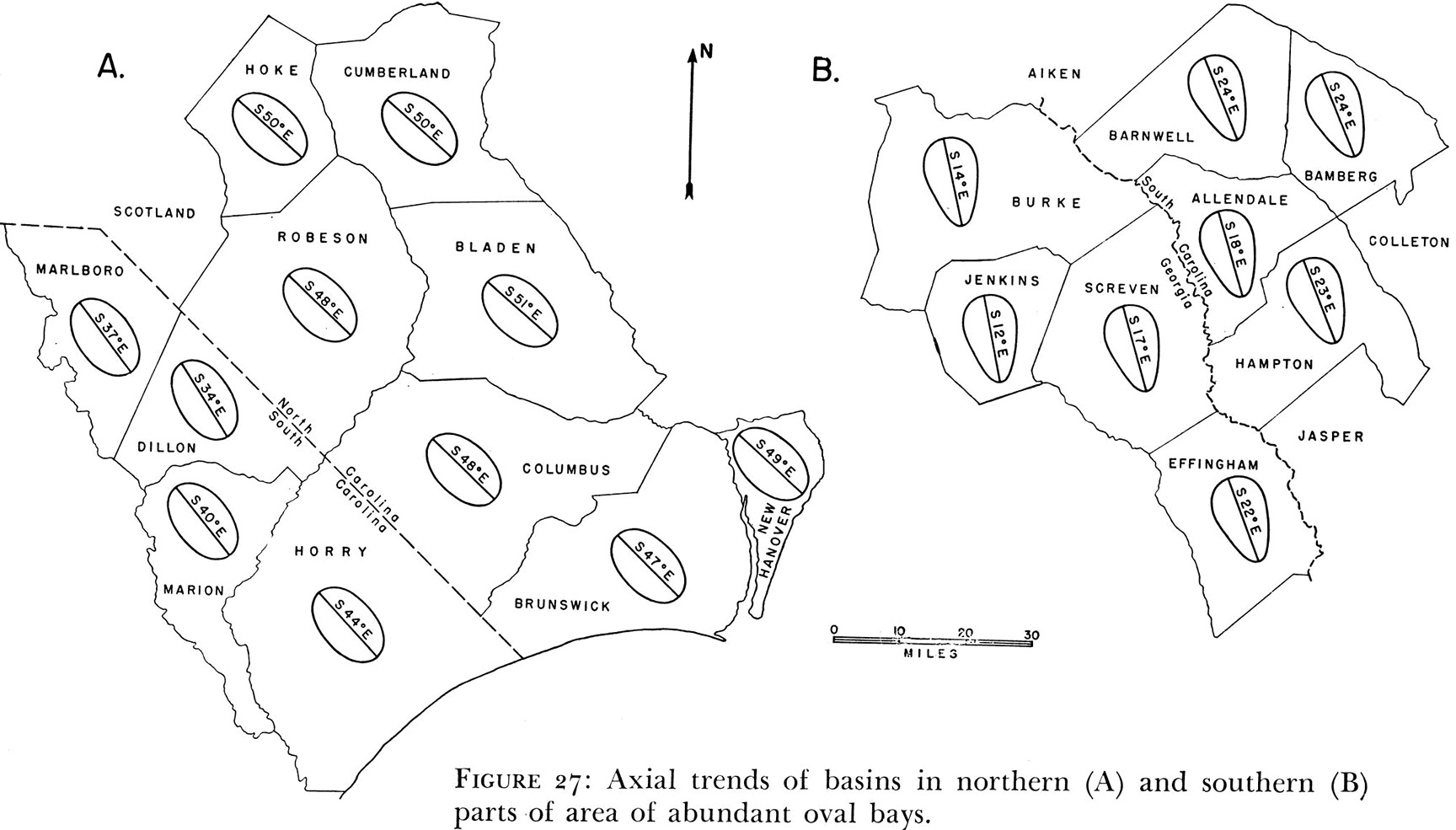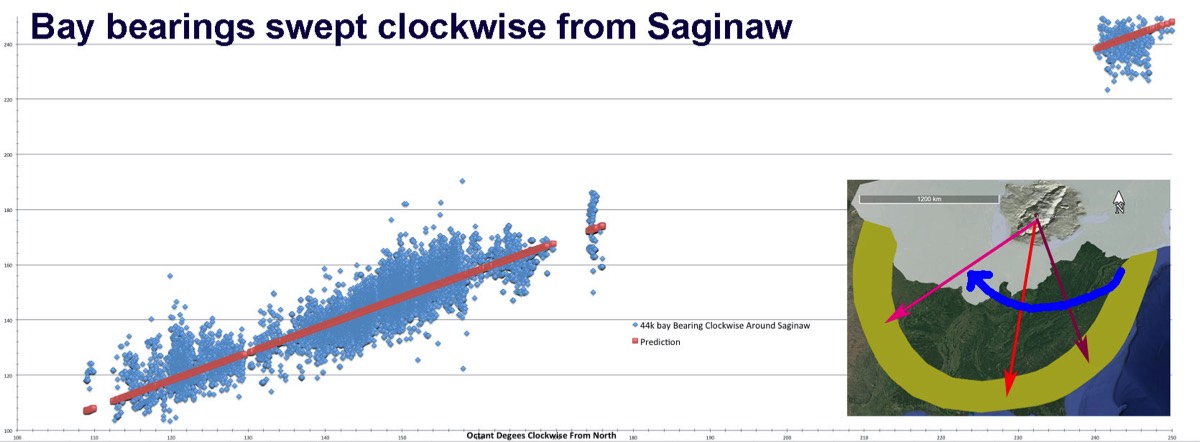Greetings! Offered here is a new approach to socializing the Google Earth-based survey at Carolina Bay Survey V2, but here using a "slider" visualization tool within a generic web browser window - no Google Earth required! With it, a bay can be seen in digital elevation maps created with LiDAR, and using the slider, the planform which has been fitted to the bay can be rolled on and off. As the user controls the slider, the fit of the planform shape can be tracked against the actual rim, as the measurement overly often obscures the finely-scribed rim structure beneath it. We encourage the user to see for themselves how robustly the true shape of the bays can be matched to the planforms.
If your browser supports the feature, a click on the image will put the slider into full screen mode. The images are small, so network connectivity is not a big issue here. That's the point, as Google Earth does not reach enough of the possible audience for this conversation. And the conversation is hopefully simple: these landforms conform to an archetype shape way too robustly to be the work of gradualistic "wind and wave." I hope the visualizations will inspire the viewer to at least consider that they may have a catastrophic genesis. No, not impact craters (they are far too shallow), but perhaps some other collateral damage from an impact event during the Pleistocene. And no, not the YDB, as they are far too ancient to be younger than hundreds of thousands of years old.
Our first 500 bays are drawn for a pool of 15,000 bays found within two USGS 1º quadrants: Florence_W and Florence_E. They can be seen a this LINK, or by following the menu: bayCarolina > 500 Large. Among these bays are a number of the largest, comprised of a complicated assemblies of planforms. The set also includes about 50 smaller bays that are cohorts of larger bays, meaning they are conjoined or integrated in making up the present shape of a basin. A selected subset of 250 single bays is also available at the bayCarolina > 250 Singles menu item.
Bays can be moved though using the arrows at the bottom of the page (Largest to Smallest), or by selecting any of the indexes shown on the page. For instance, you might have a look at all the bays that have an eccentricity of 0.76 using this LINK. Or perhaps view all the bays that are tagged as presenting a "bow" formation HERE. Similarly, all bays in the major axis category having a value between 1600 and 1700 meters can be accessed via the1600 link.
Google Earth users can also dive into a presentation of all 15,000 bays in the two quadrants with this KMZ. It's only 4 kilobytes in size, and gets all data from network links to my servers. Accessing this requires a high bandwidth network connection, and lots of memory for cache. Not good for use on cell phones; perhaps a high-memory iPad using the latest Google Earth app on a WiFi connection. Best on a powerful desktop.
Future work will include expanding the bayCarolina "slider" pages to a total of 1500 bays (10%), hopefully creating a statistically relevant presentation of their family relationship. Adding similar sets of bays for the other archetype planforms identified in the Survey is a long range goal.
This Survey Version #2 was created to re-engineer our previous efforts, which were built using the Google Fusion Table facility as a geospatial access tool. Google turned down that service in December of 2019. To access the entire survey of 60,000 basins, please use this LINK.
If your browser supports the feature, a click on the image will put the slider into full screen mode. The images are small, so network connectivity is not a big issue here. That's the point, as Google Earth does not reach enough of the possible audience for this conversation. And the conversation is hopefully simple: these landforms conform to an archetype shape way too robustly to be the work of gradualistic "wind and wave." I hope the visualizations will inspire the viewer to at least consider that they may have a catastrophic genesis. No, not impact craters (they are far too shallow), but perhaps some other collateral damage from an impact event during the Pleistocene. And no, not the YDB, as they are far too ancient to be younger than hundreds of thousands of years old.
Our first 500 bays are drawn for a pool of 15,000 bays found within two USGS 1º quadrants: Florence_W and Florence_E. They can be seen a this LINK, or by following the menu: bayCarolina > 500 Large. Among these bays are a number of the largest, comprised of a complicated assemblies of planforms. The set also includes about 50 smaller bays that are cohorts of larger bays, meaning they are conjoined or integrated in making up the present shape of a basin. A selected subset of 250 single bays is also available at the bayCarolina > 250 Singles menu item.
Bays can be moved though using the arrows at the bottom of the page (Largest to Smallest), or by selecting any of the indexes shown on the page. For instance, you might have a look at all the bays that have an eccentricity of 0.76 using this LINK. Or perhaps view all the bays that are tagged as presenting a "bow" formation HERE. Similarly, all bays in the major axis category having a value between 1600 and 1700 meters can be accessed via the1600 link.
Google Earth users can also dive into a presentation of all 15,000 bays in the two quadrants with this KMZ. It's only 4 kilobytes in size, and gets all data from network links to my servers. Accessing this requires a high bandwidth network connection, and lots of memory for cache. Not good for use on cell phones; perhaps a high-memory iPad using the latest Google Earth app on a WiFi connection. Best on a powerful desktop.
Future work will include expanding the bayCarolina "slider" pages to a total of 1500 bays (10%), hopefully creating a statistically relevant presentation of their family relationship. Adding similar sets of bays for the other archetype planforms identified in the Survey is a long range goal.
This Survey Version #2 was created to re-engineer our previous efforts, which were built using the Google Fusion Table facility as a geospatial access tool. Google turned down that service in December of 2019. To access the entire survey of 60,000 basins, please use this LINK.
Their very randomness of grouping and scatter demands an explanation. As a statistical phenomenon, they deserve to be studied statistically.
W.C. Rasmussen, 1953
Dr. Douglas Johnson documented two species of Carolina bay planforms with figure 27 from his book The Origin of the Carolina bays: the oval and the teardrop.

Johnson also characterized the rims of bays as being a broad, flat pediment that surrounds these gentle depressions. We call this out, as may geologists consider only the superficial wind-driven dunes which decorate a small percentage of southeastern bay rims as being the "rim" of the bay. many researchers are totally enamored in those dunes, and spend all their time investigating when those dunes were emplaced. As if that had anything to do with the creation of the bays!

The Carolina Bay Survey has identified six planforms which satisfactorily match the geospatial 2-D shape of Carolina bays. The six shapes are generally specific to geographic regions, although some overlap exists where one shape transitions into another. One shape found rarely is a pure oval, while the other five are slight variation on the basic oval shape. These have been named bayWest, bayBell, bayShore, bayOval, bayCarolina, & baySouth, respectively as they are found on clockwise rotation from Nebraska to Louisiana.

Our observation that these planforms map robustly to the bay types, and the indicated orientations rotate systematically by their spatial relationship to the Lower Peninsula of Michigan, suggests to us they are related to a cosmic event at that focus.
